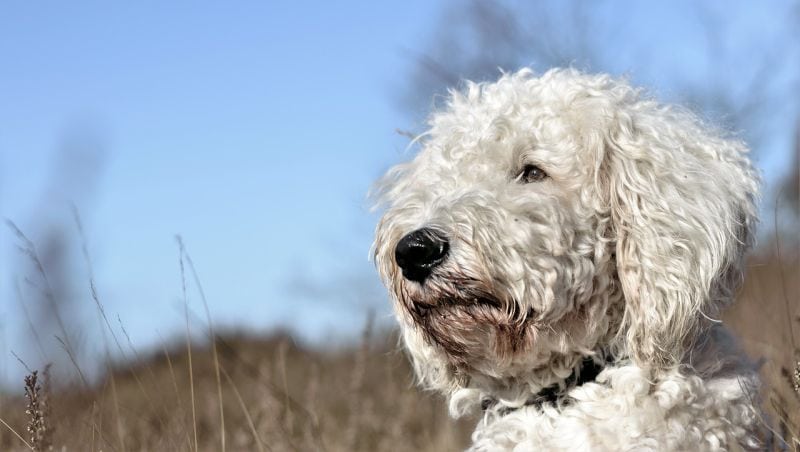But there are so many adorable doggos to choose from, where do you begin? How will you decide? Well, let’s start with their physical appearance – more specifically – their magnificent manes.
Whether you prefer a dog with silky, coarse, long, or short hair, the options are endless. You can even choose between straight and curly-haired pups.
As a curly haired gal myself, I am quite drawn to the breeds with looping locks. Hey – it’s been said that with time, dogs start to resemble their owners. Any curly haired puppy of mine would be halfway there!
Below, we’ll share some of the most notable curly-haired dog breeds and tell you a little about each. This way, you can determine which one would be the best to add to your family!
Some Curly Haired Dogs Are “Hypoallergenic”
All dogs shed, but some dogs shed much less than others. This makes many curly canines great for homes with people who’re allergic to dogs.
In fact, you’ll often see curly haired breeds — including, most notably, poodles and poodle mixes — labelled as “hypoallergenic.” Now, these dogs can still trigger allergies in humans, but they’re much less likely to do so than breeds who shed large amounts of fur (looking at you, huskies).
Even if you aren’t allergic to doggo dander, you may appreciate the fact that these dogs make it easier to keep your carpets, couch, and clothing relatively dog-hair-free.
Caryn Anderson combines extensive behind-the-scenes writing experience with her passion for all things food, fashion, garden and travel. Bitten by the travel bug at the age of 15 after a trip to Europe, Anderson fostered her love of style and fashion while living in New York City and earning her degree at New York University.
Some folks choose to groom their dog’s whiskers. Most often, whiskers are groomed for dog shows. This creates a smoother look around the face and is more likely to score points from the judges. Although trimming a dog’s whiskers doesn’t hurt the dog, it does remove an important tool she uses to explore her world. For the most part, your dog uses her nose and sight to explore, but when she’s close to an object, her whiskers garner her extra sensory information. Even curly whiskers have a rich nerve supply, making them useful tools in discovery. Unless you’re a groomer yourself, it’s important to consult a groomer before snipping your dog’s whiskers.
Whiskers are long hairs that protrude from the side of your dog’s muzzle. Sometimes whiskers are also located along the forehead and chin. More than double the thickness of regular hair, whiskers are extremely long. For most dogs, whiskers are pin straight, but for some dogs they curl.
All whiskers are hair. Whiskers may be thicker and longer than coat hair, but theyre still hair with the same biological makeup. According to L’Oreal’s Hair Science, hair shape also depends on the “cross section and the way it grows.” Hair studies have indicated that hair shape is impacted by the placement of the hair follicle on the scalp. If youve noticed that your dog’s hair curls around his scalp, but is straight along his muzzle, this curling is likely caused by the placement of the curl. Your dog’s scalp is acting like a mold and shaping the hair. Because all hair is biologically dead material, the hair retains its shape even after growth.
Straight-haired dogs sometimes end up with curly whiskers. This phenomenon is rare, but it does happen, especially in mix-breed dogs with a long history of mixing curly haired breeds with straight-haired breeds. For example, if your dog’s mother is a doxie-chon, or Bichon frise mixed with a Dachshund and her father is a straight-haired Dachshund, your girl could have curly whiskers, despite her pin-straight hair. Genetics play a big role in determining how your dog will look.
Don’t Forget About Mixed-Breed Canines with Curly Hair!

In addition to the breeds discussed above, there are plenty of mixed-breed pooches with curly hair.
Usually, mutts with curly hair have at least one parent (and sometimes two) with curly locks themselves. This means you should expect some classic canine combos to have curly, wavy, or frizzy hair.
A few of the most notable curly haired mutts include:
Hmmmm…it’s almost like all of these breeds have something in common!
Unsurprisingly, most poodle mixes end up with curly hair. But truthfully, mixes of other curly coated canines also have looping locks.
That most notably includes bichon frise mixes, but you’ll find a number of Maltese mixes that have one curly haired parent too.
FAQ
What breed of dog has curly whiskers?
Breeds with curly coats, like the Bedlington terrier, are more prone to curly whiskers than straight-haired breeds, like the Dachshund. It’s rare to find a Dachshund, or other straight-haired breed, with curly whiskers, but it does happen on rare occasion.
Is it normal for dogs to have curly whiskers?
What do curly whiskers mean?
What dogs have curly coats?
- Portuguese Water Dog. If you’re looking for a swimming partner, look no further than the Portuguese Water Dog. …
- Havanese. …
- Curly-Coated Retriever. …
- Lagotto Romagnolo. …
- Puli. …
- Bouvier de Flandres. …
- Kerry Blue Terrier. …
- Irish Water Spaniel.